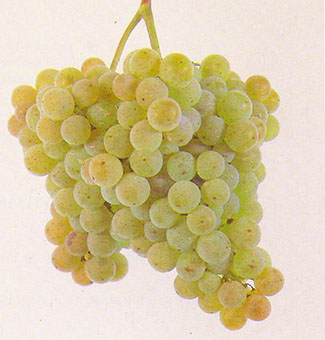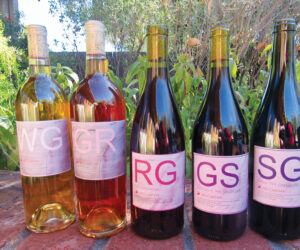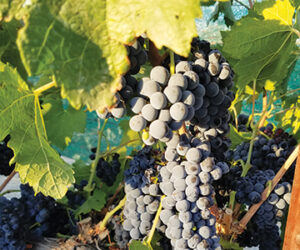 Tucked into the northwest corner of the Iberian Peninsula is the Spanish region of Galicia. Galicia is a small area, a little over 11,000 square miles, or just slightly larger than the state of Vermont. The region is rich in history going back to the times of the Neanderthals. There’s no record of this issue’s grape variety going back that far, but it is an old variety — perhaps around since the 12th century — that has adapted to the cool maritime climate and integrated itself into the local culture as well. Galicia is generally not considered one of the major grape growing regions in Spain, but the wines produced there are becoming better known outside the region based on their high quality. Most of the wines of Galicia are whites, and Albariño is one of the most popular there and throughout Spain. Albariño is a variety that I became familiar with a few years back when we planted a couple acres of it in our new vineyard at the Robert Mondavi Institute at the University of California-Davis.
Tucked into the northwest corner of the Iberian Peninsula is the Spanish region of Galicia. Galicia is a small area, a little over 11,000 square miles, or just slightly larger than the state of Vermont. The region is rich in history going back to the times of the Neanderthals. There’s no record of this issue’s grape variety going back that far, but it is an old variety — perhaps around since the 12th century — that has adapted to the cool maritime climate and integrated itself into the local culture as well. Galicia is generally not considered one of the major grape growing regions in Spain, but the wines produced there are becoming better known outside the region based on their high quality. Most of the wines of Galicia are whites, and Albariño is one of the most popular there and throughout Spain. Albariño is a variety that I became familiar with a few years back when we planted a couple acres of it in our new vineyard at the Robert Mondavi Institute at the University of California-Davis.
Of the two million or so acres of vineyards in Spain, less than 1 percent is located in Galicia. The region is relatively isolated from the rest of the country and is considered autonomous from Spain because of the culture and language differences. Historically, the wines produced in this region were the “local” wines and as we’ll see, the wines of Galicia — because of its isolation — tend to take on a greater similarity to the wines of Portugal, its neighbor to the south.
Within Galicia, there are three provinces: A Coruña, Ourense, and Pontevedra. Pontevedra is home to the most well-known wine region, Rías Baixas (ree-ahs buy-shuss) where over 90 percent of the white wines produced there are made from Albariño and almost 100 percent of them bear the Denominación de Origen (DO) classification. The classification DO is the Spanish equivalent to the French Appellation d’origine contrôlée (AOC) set up to distinguish the unique characters of a region based on geography and culture.
Within Rías Baixas there are five sub regions. A very interesting and varied mix of terrain from flat coastal plain to low mountains to terraced hillsides. The range in elevation is from sea level to almost 1,000 feet. There are more than 6,500 growers over 8,650 acres. It doesn’t take much math to see that most of the vineyard plots are small. When you factor in that the individual vineyard plots number almost 20,000, then the size of the vineyard becomes very small.
To the south of Galicia lies the country of Portugal. There, Albariño is known as Alvarinho. The Spanish and Portuguese have a long history of war and peace, but the grape knows no boundaries. Here, the name changes where the cartographer drew the border. I visited Portugal in 2007 and then again in 2010. I was most fascinated by these old traditional vineyard plots. This was the Old Country and everyone had vines in their backyard. Long ago, they knew what grew best in their region. What we know about Albariño/Alvarinho is it’s likely one of the endemic grapes of Portugal, adapting well to the cool maritime climates on the western Iberian Peninsula. There are reports that the grape is a clone of the German variety Riesling. But I don’t think these reports are factual as Albariño/Alvarinho is reported to date back to the 12th century and Riesling first pops up in the 15th century. The report of Albariño being a Riesling clone likely comes from the religious pilgrimages by Germans to Santiago de Compostela, a holy city in Galicia. In the vineyard, the varieties look quite different.
What fascinated me most about looking at these little vineyard plots was how they maximized the use of their land. What did they need? Well, food, of course, in the form of a vegetable garden, and then wine. To make their family wine, they needed grapes, which were grown in a trellis system above their vegetable gardens in order to shade and protect the garden year-round. The elevated trellis system, think of it as an arbor or pergola, allowed airflow above and below the fruit so that mold and mildew wasn’t an issue in this cool climate. Of course, the fruit produced some good wine as well.
In the traditional land, Albariño/Alvarinho produces wines that are crisp in acidity and low in alcohol. This is typical of a cool region grape and akin to Chardonnay from Burgundy or Sauvignon Blanc from New Zealand. The grapes have thick skins that contribute to a high aromatic quality that is typically sweet with aromas of citrus, apples, peaches, almonds, grass and flowers.
An interesting twist on the wines made from Albariño/Alvarinho is the Vinho Verde wines of Portugal. Directly translated, Vinho Verde mean “green wines.” And in these cool maritime regions, sometimes the grapes do not reach their full maturity we expect in the classic dry white wine style and they are harvested early, perhaps before 20 °Brix has been achieved. What results is a very crisp, classy wine that is low in alcohol. What makes Vinho Verde unique is its spritzyness, or effervescence. Essentially, the wine is bottled with about one atmosphere equivalent of carbon dioxide. The style came about quite by accident. It seems long ago, before there was any understanding of the malolactic fermentation, these Albariño/Alvarinho wines were bottled young and fresh, some cloudiness occurred in the bottle, but the slight carbonation added an extra freshness to the wines. To overcome the cloudiness, the bottle styles were switched to an opaque type where you couldn’t see the wine. Once it was understood that this was a secondary fermentation in the bottle, and the effervescence was not consistent from bottle to bottle, they began to “clean up” their winemaking process by adding sulfur dioxide, filtration and then force carbonating the wine at bottling.
Through consumer groups, the wines of Portugal and Galicia found their way to the New World. Discovery piqued the curiosity of winemakers and grape growers to see how it would fair outside its long historical range. Winemaker Alan Kinne — who brought thousands of Albariño/Alvarinho cuttings to the Untied States from Spain in the mid- to late-1990s — played a large part in introducing the grape in the states along with Bryan Babcock and Michael Havens. The variety first showed up as a varietal listing in the California grape crush report in 2009. It had previously not been significant enough to report and was lumped into the “other white grape” category. Thirty-five tons were crushed in 2009, at an average price listed of $1,634 per ton. The following year, the tonnage crushed increased to 616 tons and the price plummeted to $964 per ton. Since then the total tons crushed has increased by about 300 tons per year and the price appears stable around $1000 per ton. Outside of California, the 2012 grape report from the state of Virginia listed 24 tons crushed across 23 acres of vineyard and an average weighted price of $2,150 per ton. So what does this all mean?
What I take away from it personally is a lesson in discovery and economics. I discovered a wonderful new grape in my visits to Portugal. Other people were discovering it as well in that orders were being placed to start propagating the plant material to plant here in California. Then on the economic side, the curve was just too steep to climb. Trying to overcome the Chardonnay and Cabernet Sauvignon consumer preferences was too much. Albariño/Alvarinho was just gong to have to be a small niche grape. To sell the wine, you would have to engage in specialized focus marketing campaigns. This is something that looks to be the case in Virginia. In California, whilst there was a desire to plant more acreage, it just wasn’t panning out and the nurseries soon had a glut of Alvarinho. This was an exciting opportunity for our teaching vineyard. To the University’s benefit, the entire stock of propagated material was donated for our vineyard.
The first harvest of this vineyard was in 2012 and we decided that we would do a “green” harvest and a harvest sometime after that but more like a New World, warm climate, harvest. We were more or less looking to see how the flavors developed as the vineyard matured. The “green” harvest mimicked that of the Old World style, harvested at 21 °Brix, whole-cluster pressed, and fermented. The New World style was harvested at 24.5 °Brix. What this small project showed was the versatility of the grape. We achieved the Old World style with more flavors as a result of the fermentation bouquet, and then the New World style was a riper, more tropical flavor profile.
Back in the old country, it is the local variety, local customs, local cuisine and it has no competition from other varieties. The only real competition is whose Albariño wine are you going to buy. For the up and coming markets of the New World, keep it small, keep it focused. That first sale is made by how it is presented to differentiate it from the mainstream world of wine marketing, although, it is the quality that gets the consumer to buy another bottle.
Albariño/Alvarinho recipe (5 gallons/19 L)
Ingredients
• 100 lbs. (45 kg) Albariño fruit
• Distilled water
• 10% potassium metabisulfite (KMBS) solution. Weigh 10 grams of KMBS, dissolve into about 75 milliliters (mL) of distilled water. When completely dissolved, make up to 100 mL total with distilled water.
• 5 grams Lallemand QA23 yeast (Premier Cuvée or EC1118 can be used as a substitute)
• 5 grams Fermaid K (or equivalent yeast nutrient)
• 5 grams Di-ammonium phosphate (DAP)
• Rice hulls
• Tartaric acid (if acidity adjustment is needed)
Other equipment or needs
• 5-gallon (19-L) carboy
• 6-gallon (23-L) carboy
• 6-gallon (23-L) plastic bucket
• Airlock/stopper
• Racking hoses
• Equipment cleaning and sanitizing agents (Bio-Clean, Bio-San)
• Inert gas (nitrogen, argon or carbon dioxide)
• Refrigerator (~45 °F/7 °C) to cold settle the juice.
• Ability to maintain a fermentation temperature of 55 °F (13 °C) TIP:Use a 33-gallon (125-L) plastic can as a water bath. Place ice blocks in the water to maintain a relatively constant temperature. This will be your refrigeration system for peak fermentation. If you have other means to keep things cool, of course use that. Alternatively, you may have a need to keep it warm, in this case wrapping the bucket/carboy with an electric carboy wrap works well.
• Thermometer capable of measuring between 40–110 °F (4–43 °C) in one degree increments.
• Pipettes with the ability to add in increments of 1 mL
Step by Step
1. Clean and sanitize all your winemaking tools, supplies and equipment.
2. Crush and press the grapes. Crush to a bucket and mix in rice hulls. The ratio of must to rice hulls should be about 70% must to 30% rice hulls. The rice hulls aid in pressing by creating juice channels. Your juice yields will increase significantly with their use. Move the must/rice hull slurry directly to the press and press. Do not delay between crushing and pressing.
3. Transfer the juice to a 6-gallon (23-L) bucket. During the transfer, add 16 mL of 10% KMBS solution (This addition is the equivalent of 40 mg/L (ppm) SO<sub>2</sub>). Move the juice to the refrigerator.
4. Let the juice settle at least overnight. Layer the headspace with inert gas and keep covered.
5. When sufficiently settled, rack the juice off of the solids into the 6-gallon (23-L) carboy and let the juice warm up to room temperature.
6. Measure the Brix and acidity.
7. Adjust the acidity to 6.0-7.0 g/L if necessary with tartaric acid.
8. Prepare yeast. Heat about 50 mL water to 104 °F (40 °C). Sprinkle the yeast on the surface of the water and gently mix so that no clumps exist. Let sit for 15 minutes undisturbed. Measure the temperature of the yeast suspension and juice. You do not want to add the yeast to your cool juice if the difference in the temperatures exceed 15 °F (8 °C). To avoid temperature shock, acclimate your yeast by taking about 10 mL of the juice and adding it to the yeast suspension. Wait 15 minutes and measure the temperature again. Do this until you are within the specified temperature range. Do not let the yeast sit in the original water suspension for longer than 20 minutes. When the yeast is ready, add it to the fermenter.
9. Add Fermaid K or equivalent yeast nutrient.
10. Initiate the fermentation at room temperature (65-68 °F/18–20 °C) and once fermentation is noticed, (~24 hours) move to a location where the temperature can be maintained at 55 °F (13 °C).
11. Two days after fermentation starts, dissolve the DAP in as little distilled water as is required to completely go into solution (usually ~20 mL). Add directly to the carboy and stir thoroughly.
12. Normally you would monitor the progress of the fermentation by measuring Brix. One of the biggest problems with making white wine at home is maintaining a clean fermentation. Entering the carboy to measure the sugar is a prime way to infect the fermentation with undesirable microbes. So at this point, the presence of noticeable fermentation is good enough. If your airlock becomes dirty by foaming over, remove, clean, and replace it as quickly as possible.
13. Leave alone until bubbles in the airlock are about one per minute (usually about two to three weeks). Measure the Brix every 2–3 days.
14. The wine is considered dry, or nearly dry, when the Brix reaches -1.5 °Brix or less.
15. When the fermentation is complete, rack the wine to the 5-gallon (19-L) carboy and lower the temperature to 38–40 °F (3–4 °C) and add 3 mL of fresh KMBS (10%) solution per gallon (3.8 L) of wine.
16. After two weeks, test for pH and SO<sub>2</sub> and adjust as necessary to attain 0.8 ppm molecular SO<sub>2</sub>. (There is a simple SO<sub>2</sub> calculator at www.winemakermag.com/sulfitecalculator). Check the SO<sub>2</sub> in another two weeks prior to the next racking and adjust while racking. HINT: Rack to another sanitized 5-gallon (19-L) carboy, or your bucket. In the case of the latter, clean the original carboy and transfer the wine back to it. This is done at about 4–6 weeks after the first SO<sub>2</sub> addition. Once the free SO<sub>2</sub> is adjusted, maintain at the target level by monitoring every 3–4 weeks.
17. If needed, put the wine through a fining and filtration routine.
18. At about three months you are ready to bottle. Check SO<sub>2</sub> again and adjust as required. Be sure to maintain sanitary conditions while bottling.






